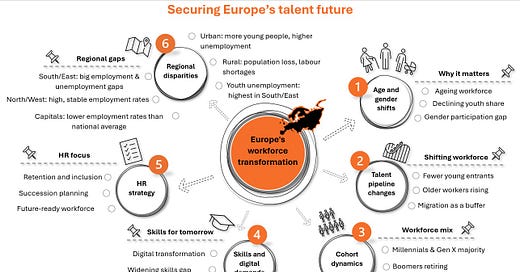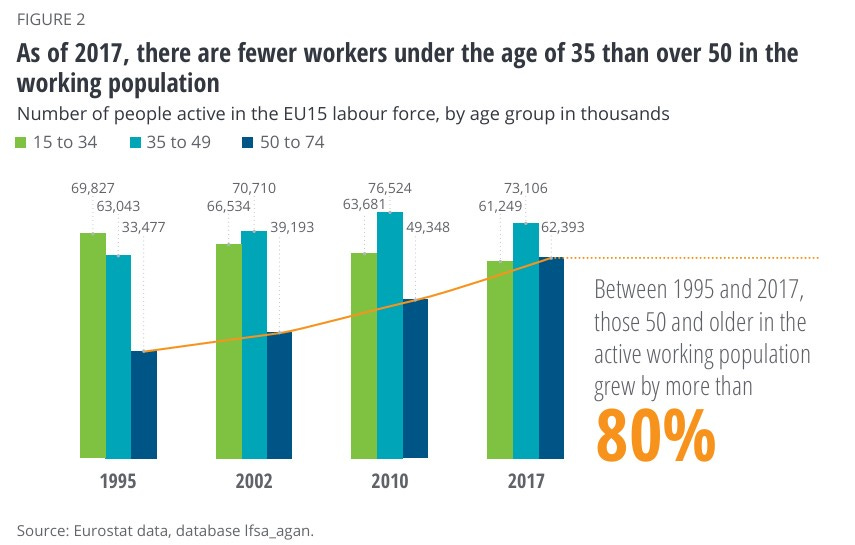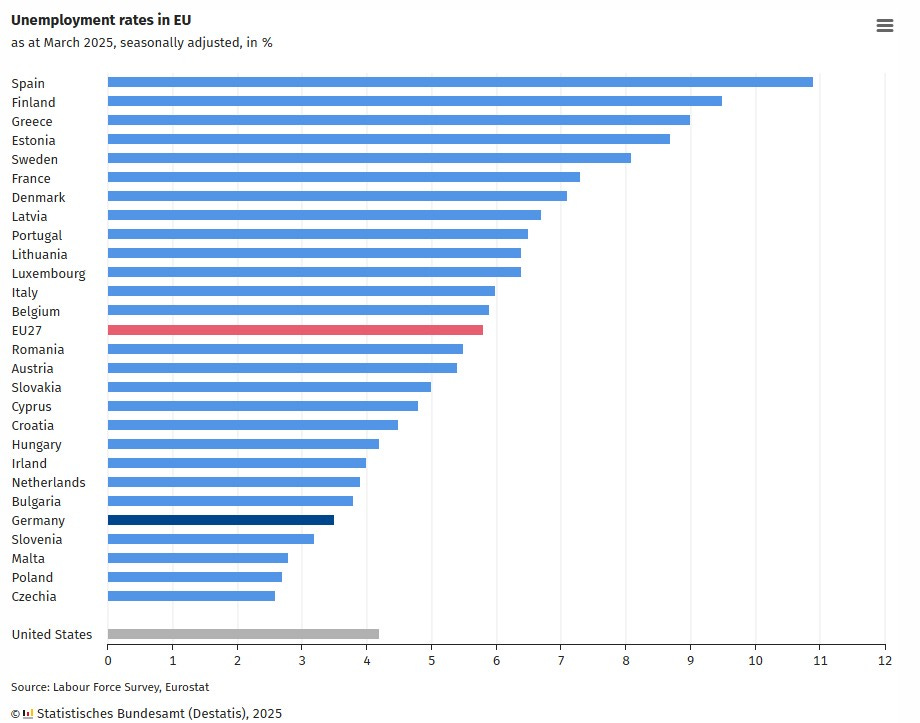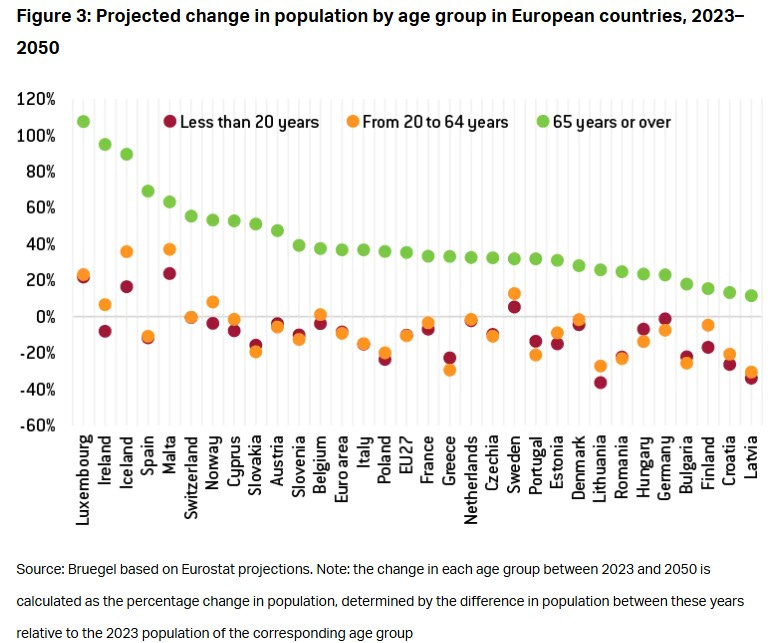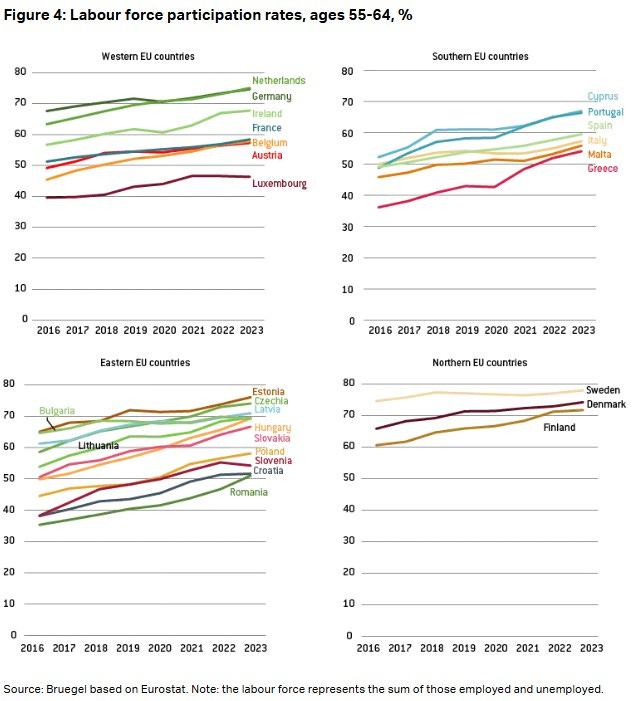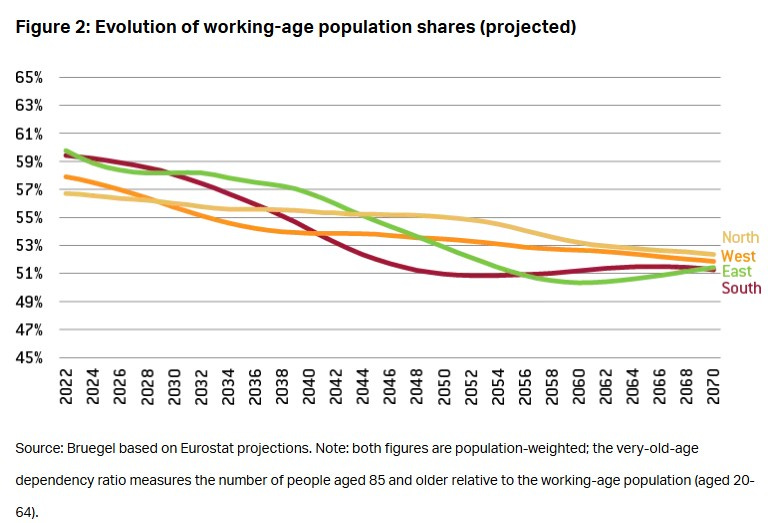Europe’s workforce shift: how demographics are reshaping talent and HR
Practical insights to help HR leaders respond to Europe’s aging workforce, skills gaps, and regional disparities—and build a resilient, future-ready organization
Europe’s workforce is changing in age, structure, and regional balance. With ageing populations, shrinking youth cohorts, and growing disparities between regions, understanding these dynamics is essential for designing inclusive labour policies, resilient talent strategies, and future-ready organisations.
What you will learn from this article:
How Europe’s ageing workforce and shrinking youth cohort are reshaping labour market dynamics
Why demographic and regional shifts matter for workforce planning and HR strategy
Which regions face the greatest employment challenges—and why disparities persist
What generational changes mean for talent development, retention, and inclusion
How migration affects regional labour markets and demographic sustainability
Why skills shortages are intensifying—and the role of lifelong learning in closing the gap
What organisations and policymakers can do to build a resilient, future-ready workforce
Why it is relevant to HR?
Demographic shifts are reshaping talent supply across Europe. HR leaders must respond to ageing workforces, regional disparities, and shrinking youth cohorts by rethinking workforce planning, retention, and skills development. These trends directly affect hiring, succession, and productivity. A strategic, data-driven HR approach is essential to maintain competitiveness and ensure long-term organisational resilience.
Table of contents:
How Europe’s changing age and gender mix is reshaping the workforce
Why regional disparities matter for Europe’s workforce and business success
How ageing, youth decline, and migration are transforming Europe’s talent pipeline
How digital transformation and sector trends are driving new skills needs and talent shortages
Final thoughts: what Europe’s demographic shifts mean for your workforce strategy and future readiness
Key takeaways
What is next
How Europe’s changing age and gender mix is reshaping the workforce
Europe’s workforce is ageing steadily. In the EU-27, the share of workers aged 55 and over grew from 12% in 2004 to 20% in 2019. If current trends continue, this could rise to 38% by 2028. By 2017, the number of workers under 35 had already fallen below the number of those over 50, with each group making up roughly 30% of the workforce.
These shifts reflect several long-term developments: declining birth rates, longer time spent in education, later entry into the labour market, and rising retirement ages.
The generational balance illustrates this clearly. Baby Boomers now represent a shrinking share, though many remain active, particularly between ages 55 and 64. Generation X and Millennials each account for about 30% of the workforce and form its main body. Generation Z is growing but still represents only 10–15%, with many in full-time education and relatively low labour market participation among 15–24-year-olds (about 41% across the EU).
“Europe’s working-age population is projected to shrink by more than 30 million people by 2050, with the largest declines expected in Eastern and Southern Europe. The demographic transition will have significant implications for labour markets, social protection systems and economic growth.”
— European Parliament Briefing, 2025

Why regional disparities matter for Europe’s workforce and business success
The headline employment figures hide large differences across European regions. The EU-wide employment rate hit a record 75.3% in 2023 and continued to increase in early 2025. However, regional gaps remain stark.
How employment and unemployment trends shape workforce planning
Northern and Western Europe—including Germany, the Netherlands, Denmark, and Sweden—tend to maintain high, stable employment levels with fewer regional disparities. In contrast, Southern and Eastern Europe—such as Italy, Greece, Spain, and Romania—experience much wider variation. Some southern regions in Italy and parts of Spain report employment rates below 50%, while others reach or exceed 80%.
💡 Related read:
The “Great Resignation” in Europe: What really happened and what is next?
Explore how workforce trends and talent shortages are reshaping Europe’s labor market—and what HR leaders can do to adapt.
Interestingly, capital regions do not always lead. In countries like Belgium, Germany, and Austria, capital areas have lower employment rates than other parts of the country.
By early 2025, the gender employment gap in the EU had narrowed to about 10 percentage points—a historic low—but large differences remain, particularly in Southern and Eastern Europe.
Unemployment also shows significant regional variation. In March 2025, the EU average stood at 5.8%, and the euro area at 6.2%. Some of the lowest rates were in Czechia, Poland, Malta, and Germany (below 3%). The highest were in Southern Europe, with parts of Spain and Greece exceeding 17% and youth unemployment over 25%.
Countries such as Italy, Belgium, Austria, Hungary, and Romania see wide internal disparities, with some regions recording unemployment several times higher than others. Urban areas, including capitals like Brussels, Vienna, and Berlin, often face higher unemployment than national averages.
Why understanding ageing and population shifts is critical for talent strategy
Eastern and Southern Europe are experiencing faster ageing and steeper declines in working-age population. These trends are driven by low birth rates, outmigration, and limited immigration. By contrast, Northern and Western Europe are ageing more slowly, supported by higher fertility rates and greater inward migration.
Urban areas generally attract younger populations, while rural and peripheral regions—especially in the East and South—face shrinking populations and accelerated ageing.
How urban, rural, and capital region trends impact talent availability
Cities continue to draw younger workers and migrants, but many also face rising unemployment and other labour market challenges. Rural and remote regions, particularly in Southern and Eastern Europe, are losing population and economic activity, leading to labour shortages and reduced economic prospects.
How migration is changing regional labour markets—and what it means for HR
Migration helps offset workforce decline in Northern and Western Europe, supporting labour market stability. However, many regions in Southern and Eastern Europe are losing young, skilled workers. Most migrants settle in urban centres, which further deepens the urban-rural divide.
Migration brings younger, working-age individuals into the labour market and supports economic growth. Still, it cannot fully compensate for broader demographic trends, particularly since many sending countries are also ageing. Policy responses and the success of migrant integration vary widely and strongly influence the extent to which migration can alleviate demographic pressures.
What every HR leader should remember about Europe’s evolving workforce
Europe’s labour market is increasingly regionalised. While the continent overall faces an ageing workforce and structural transformation, Northern and Western Europe benefit from stronger labour markets and migration inflows. Southern and Eastern regions face greater challenges, from workforce decline to youth unemployment. Policymaking needs to reflect these regional differences.
How ageing, youth decline, and migration are transforming Europe’s talent pipeline
The share of workers aged 55 and over rose from 12% in 2004 to 20% in 2019 and is projected to reach 38% by 2028. By the late 2010s, the number of workers over 50 slightly outnumbered those under 35, with both groups comprising about 30% of the workforce.
“The phenomenon of population ageing is one of the most serious demographic challenges facing European countries, with far-reaching consequences for the labor market, the pension system, and the entire economy.”
— Level of Fulfilment of Expectations towards Work and Employer of Generation Z Employees
How fewer young entrants are raising the stakes for talent retention and succession planning
The population aged 15–29 is expected to shrink by 7% in Western Europe by 2050. This will make younger talent scarcer and increase reliance on older employees. Many Generation Z individuals are still in education or training, and labour market participation in the 15–24 age group remains low (around 41% in the EU). A significant number are also classified as NEET—not in education, employment, or training—which presents long-term challenges for renewing the workforce.
Why generational shifts demand new approaches to talent management
Millennials and Generation X are now the dominant groups in the labour market. Baby Boomers are gradually retiring, although many remain in work, particularly those aged 55–64. Generation Z is beginning to enter employment but remains a small share.
What these demographic trends mean for your HR strategy and workforce resilience
The declining youth cohort and growing number of older workers call for focused efforts on skills development, longer working lives, and intergenerational collaboration. Retention, inclusion, and continuous training will be key to workforce resilience and innovation.
How digital transformation and sector trends are driving new skills needs and talent shortages
Digital transformation is reshaping Europe’s labour markets. The rapid adoption of AI and other digital tools is changing job profiles and organisational structures. This affects all generations and requires greater flexibility and ongoing skills development.
Why skills shortages are intensifying—and how organizations can respond
Talent shortages are widespread. Around 77% of industrial employers report difficulty finding qualified workers. This indicates a growing mismatch between workforce skills and job requirements.
“Nearly two thirds (63%) of small and medium-sized businesses said in a Eurobarometer survey of September 2023 that they cannot find the talent they need.”
— TSI 2025 Flagship - Tackling the demographic change through supporting skills-labour market and social inclusion reforms - European Commission
How lifelong learning can bridge skills gaps and support a multi-generational workforce
As technology advances, there is an urgent need to equip younger workers for new roles and to keep older workers engaged. Lifelong learning is essential for bridging generational divides and enabling all age groups to adapt to changing work environments.
“Lifelong learning and upskilling are not optional—they are essential for all generations to remain relevant and productive in a rapidly evolving labor market.”
— Deloitte, The Future of Work in Europe
Final thoughts: what Europe’s demographic shifts mean for your workforce strategy and future readiness
Europe’s workforce is shifting in both age and structure. Millennials and Generation X currently make up the majority, while the share of older workers continues to rise. Younger generations are entering slowly, with many still in education.
If current trends hold, the over-50 group will become the largest generational segment within this decade. This transition brings both pressure and possibility. It underscores the need for inclusive employment strategies, sustained investment in skills, and a stronger focus on generational balance in workforce planning.
Key takeaways:
Europe’s workforce is ageing, with over-50s projected to become the largest segment by the end of the decade
The share of young workers is shrinking, increasing reliance on older talent and raising succession planning needs
Regional labour market disparities are growing, especially between Northern/Western and Southern/Eastern Europe
Migration helps offset demographic decline in some regions but deepens urban–rural divides
Talent shortages and skills mismatches are intensifying across sectors, especially in industry and tech
Lifelong learning and upskilling are essential to maintain productivity across all generations
HR strategies must adapt to demographic realities with a focus on inclusion, retention, and future workforce readiness
What is next:
In a world where nearly half of all core skills are set to change by 2027, the pressure is on to act deliberately. Strategic upskilling and reskilling are no longer just nice to have—they are the keys to turning uncertainty into growth.
Our upcoming feature reveals how to pinpoint skill gaps that matter, link learning directly to your organisation’s goals, and embed development into everyday work. Discover how leading companies boost retention, drive innovation, and prepare their people to adapt and thrive.
Whether you lead HR, strategy, or transformation, this is your essential guide to creating a workforce that is not just prepared—but built to lead.
What would it take for learning to become your most reliable competitive advantage?
Further reading:
The Gig Economy and Older Workers: Opportunity or Unfair Struggle?
Discover whether gig work is empowering Europe’s older professionals or trapping them in precarious jobs—and what can be done to ensure fairness for all agesThe AI Index Unveiled: How Artificial Intelligence is Reshaping Jobs and Skills
See which European jobs and skills are rising or fading as AI transforms the workplace and learn how to stay ahead in the age of automationHybrid Work as the Emerging Compromise: Finding the Right Balance
Explore how hybrid work models are reshaping Europe’s offices—and what it takes to balance flexibility, teamwork, and productivity
Readers favourites:
Remote Work in Transition: Benefits, Challenges, and Employee Preferences
Remote Work Laws You Cannot Ignore: A Global Guide to Compliance
References
Employment - annual statistics - Statistics Explained - Eurostat
Generations at work | SPREW Project | Results in Brief | FP6 | CORDIS | European Commission
Generations at work | SPREW Project | Results in Brief | FP6 | CORDIS | European Commission
Ageing Europe - statistics on working and moving into retirement - Statistics Explained - Eurostat
Level of Fulfilment of Expectations towards Work and Employer of Generation Z Employees
The role of demographics in recent developments in the unemployment rate
Labour market statistics at regional level - Statistics Explained - Eurostat
Euro Area - Gender employment gap - 2025 Data 2026 Forecast 2009-2024 Historical
Demographic changes and labour migration within the EU | Epthinktank | European Parliament

